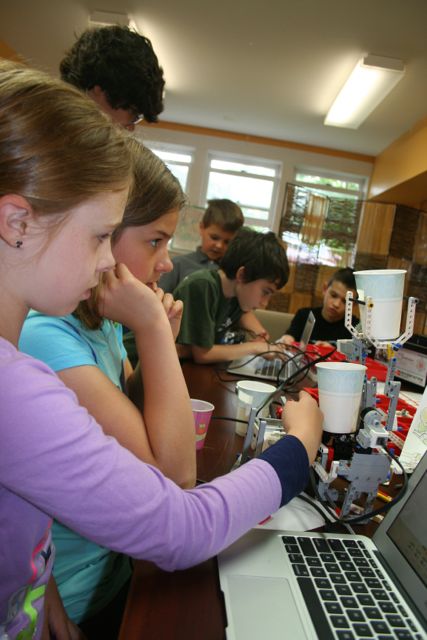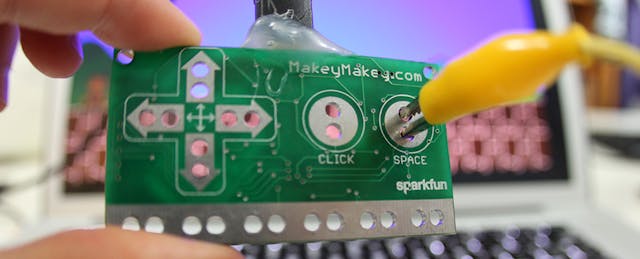Having taught science and engineering for nearly twenty years, I was recently reflecting on what has changed about the technology I use to teach STEM topics. Is it that I now infuse projects with robotics, computer-based data logging systems and rapid prototyping? Nope. On their own, these technologies are “so last-century.” Or are they?
What is new, and why is the beginning of the 21st century an amazing time to be teaching and learning STEM with digital technology tools? Let’s examine a few trends.
Increased ease of use
When I first started using robotics and data collection sensors in the classroom, we used the Rug Warrior, HandyBoard, and BASIC Stamp systems. They were all great systems and my students built some very cool projects, but it took a considerable amount of class time to complete a project. The 21st century has provided systems that are much easier to use while still retaining the high or higher ceiling of possibility.
For instance, when I am teaching students a physics lesson on motion, the students can plug and play with a measurement system from Vernier Technology in minutes. This supports both quick, impromptu, investigations based on student curiosity or extended labs where the data collection technology is not the focus; the science questions themselves are the focus.
Often, however, I want the students to build the systems they explore. For example, in some of my labs during a unit on motion, students will build a robot (see Figure 1), program it, and use it in a lab by the end of a class period. Their robot, built from the LEGO® MINDSTORMS® Education kit, can then be modified and reused quickly in other investigations throughout a unit.
I have students build their own science tools because if they’ve built it, they make it their own. And if they own it, they are more engaged in the lesson. To do this in such a short span of time 20 years ago would have been impossible.
But what is the benefit of this “ease of use”? For teachers, it takes less time to learn the basics of the tools, it is easier to learn more about the tools while incorporating them into your lessons, and more projects can be worked on per year.
The most important benefit, however, is for the students themselves. Because the tools are easier to use, students can explore multiple ideas per project by comparing many solutions to design tasks or multiple iterations for measurement and investigation tasks. In other words, students can iterate and optimize their own designs.
For example, in one engineering project completed by two of my students last year, they built and prototyped three versions of a vending machine. They started with LEGO bricks and push-switch controlled motors, progressed to a MINDSTORMS NXT for the brains of their machine, and ended with a design built from LASER cut parts, custom sensors, and a web-based user interface they created on a single board computer (pcDuino). Their instructable documents their latest version of the project. This project represents one high ceiling that I love seeing students reach for!
Technology tools are applicable for very wide age ranges
Another development of the 21st century is the educational lifespan of a product. I can purchase a certain technology knowing that the same platforms are being used for multiple age groups. This summer, for instance, I led summer camps for kids as young as 8 and as old as 18 with the LEGO EV3. Our younger students quickly grasped how to control the motors, create sequences of action and write programs to control robot behavior depending on sensor input.

Our older students, with the same tools, were off to the races. In one project, a student created a robot to play a guitar; in another, they created a working model of a 3D printer complete with X,Y, and Z movements and a hot glue-based print head!
And these tools don’t stop there. I typically show my high school students how and where the tools can be used after graduation because, as in many cases, students are programming and using engineering tools that real-word scientists use. This helps them buy into the investment of learning the tool. During the school year, I teach high school classes using LEGO MINDSTORMS, the National Instruments myDAQ, and Arduino systems via the LabVIEW graphical programming environment (Figure 2). All four of these technologies are used in university classes, and LabVIEW is used widely in industries, as well. It’s the same tool--but across a very wide age range!
More affordable rapid prototyping and fabrication tools
When I started this blog piece, I alluded to using rapid prototyping tools in my classroom in the 1990’s. While I had observed 3D printers at places like Dartmouth and Tufts University in the late 90’s, the rapid prototyping tool I used in my classroom was a hot glue gun! Much has changed on this front in the last two years now that I have access to a MakerBot, several Printrbot Simple machines, and a Full Spectrum LASER CNC machine.
In my own teaching, access to these tools has enabled me to explore two things. On the one hand, I can explore making science kits for my classes and very specific learning tools such a plastic shield for LED’s to make seven-segment displays (Figure 3). On the other hand, students can push their own designs by designing pieces for their own construction kits, making custom pieces that suit their personal interests, or taking on really big projects such as reinventing a vending machine system.
Emerging opportunity to blend technologies into the same project
To me, the most exciting thing that I am now seeing with technology use in my classes is the blending of tools together.
Inspired by the Maker Movement, my students and I have completed projects that include Arduino-based sensors and custom 3D printed parts on MINDSTORMS robots; custom outdoor data loggers with LASER cut enclosures, Arduino brains and Vernier sensors; LEGO Education WeDo motors programmed using Scratch on a $35 Raspberry Pi computer; and more. “What will you make?” is the mantra of the modern Maker Movement, where the possibilities are only constrained by your imagination, and we definitely live that out to the fullest.
If the 20th century helped define certain alphabet letters--T for transistors, C for computers and R for robots, the 21st century is all about taking that alphabet and creating an almost limitless set of words, sentences, and stories. It certainly is a great time to be a student or teacher in STEM!


